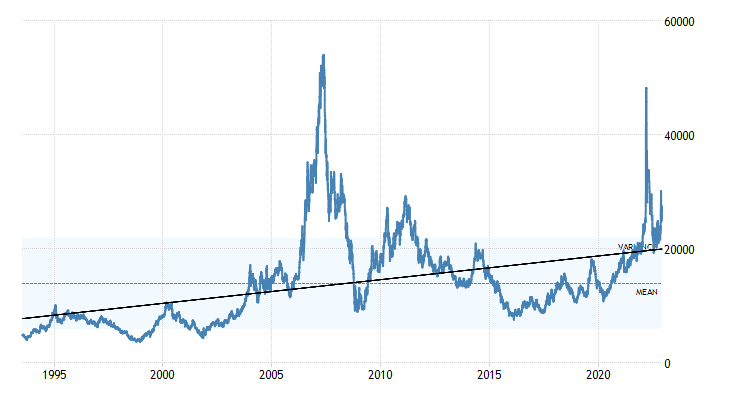The ISM Manufacturing Index (PMI) fell to 49 in November, the lowest mark since May of 2020. The change from October (50.2) wasn’t stark, but the reading below 50 does indicate a contraction of the manufacturing sector for the first time in 29 months. Order backlogs, prices, and deliveries are all showing signs of softening. Demand is also weakening, helping to ease supply chain bottlenecks and moderate inflation.
Consumer Confidence fell for the second consecutive month in November, slipping to 100.2 from October’s 102.2 mark. Inflation was a primary contributor to the decline in sentiment, with survey respondents indicating less home, auto, and major appliance purchases.
WTI Oil spent much of November slowly and steadily falling. Starting at $88.37 per barrel, oil peaked at $92.61 on the 4th and then drifted down until ultimately closing at $80.55 per barrel. Perhaps the largest factor in the decline has been another round of COVID lockdowns in China, suppressing demand. If and when the lockdowns ease up, look for oil to rebound.
The online US Oil Rig Count is at 784 which is up 14 compared to last month’s report and up 215 from December 3 of 2021 (a high of 1609 in October of 2014 before oil pricing dropped below $20 per barrel at the end of that year). This key and leading indicator shows the current demand for products used in drilling, completing, producing, and processing of hydrocarbons which all of us use every day as fuel sources and finished products.
Nickel went on a wild ride in November, starting the month at $10.66/lb., soon after racing to $13.64/lb., then partially correcting to close at $12.24/lb. While no one knows exactly what triggered the quick escalation, it appears that some combination of a short sale gone wrong, an explosion at a producer in Indonesia, and a mine waste issue in New Caledonia are the culprits.
Below is the 90 day Nickel Price Trend (US$ per tonne).

Domestic steel plate mills announced in late November that they would implement a $140/ton price decrease. With more plate producing capacity coming online late this year, prices are trending back down toward levels we have been accustomed to seeing.
Commodity stainless and Duplex plate deliveries remain in the 7 to 12 week range, while Nickel alloy plates range from 12 to 26 weeks. Carbon Steel plate mill deliveries reside in the 6 to 10 week delivery range.
Welded tubing –Smaller quantity deliveries remain in the 10 to 16 week range, with larger quantity orders still in the window of 18 to 25 weeks. Carbon steel tubing deliveries have lead times ranging anywhere from 8 to 14 weeks when strip is available. Welded nickel alloy tubing ranges from 18 to 24 weeks, with some cases of 30 week deliveries.
Seamless tubing – Current schedules reflect 10 to 20 weeks or more for carbon steel (24 to 26 weeks for Western European carbon seamless) and 8 to 30 weeks for stainless. Seamless nickel tubing is being offered at the 8 to 12 week delivery window so long as hollows are in stock. If hollows are not readily available, anticipate deliveries of seamless nickel tubing in the 20 to 32 week timeframe.
The metal market continues to be in a tremendous state of uncertainty and price volatility, so please don’t hesitate to reach out if you have any questions.
Here’s the current surcharge chart for 304/304LSS, 316/316LSS, 2205, C276, and 625.

Nickel Prices have had an interesting ride over the past two decades with a low of $2.20/lb. in October of 2001 (following September 11 events) and a high of $23.72/lb. in May of 2007. Surcharges trail Nickel prices by approximately two months, so they would have been at their lowest in December of 2001 (304 was $0.0182/lb.) with the peak in July of 2007 (304 was $2.2839/lb.).
The chart below illustrates Nickel price by way of U.S. Dollar per Metric ton.

Here’s the Price Index for Hot Rolled Bars, Plate, and Structural Shapes.








